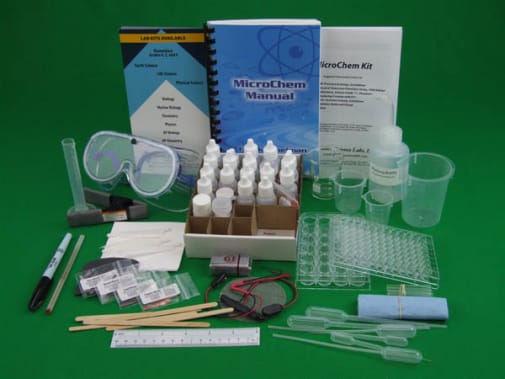Chemistry labs can be scary and overwhelming, especially if you don't have a curriculum that lays them out for you. It can be expensive to buy the equipment and many of the chemicals are restricted and difficult to obtain.
MicroChem Experiment Lab is a kit that takes away some of the pressure and expense of those high school chemistry labs. This kit includes scaled-down amounts of chemicals (about 1/100th the usual amount) and is enough to do experiments about 5 times. By scaling back on the chemicals and using plastic equipment (where possible) the cost is controlled a bit and there is less of a problem with chemical disposal at the end of the course. Chemicals come in dropping' bottles, so they are ready for use. No mixing and less spilling is a definite benefit to this kit. Experiments may cause for a drop' or drops' of a chemical, so the special bottles are great for dispensation.
The kit includes a 119-page manual that contains introductory information, how to use it, and safety information. The manual includes experiments and instruction for each goals, materials/equipment needed, background information, and step-by-step procedures. Suggested answers are given for questions in each experiment, and solutions to experiments are included at the back of the manual. If you are already using a curriculum and just need labs, an included chart shows correlation to A Beka Chemistry, 2nd ed.; ACE Chemistry, 1996 ed.; Alpha Omega Publications, grade 11 Chemistry; Apologia Exploring Creation with Chemistry; Bob Jones Chemistry, 3rd ed.; Glencoe Science, Chemistry: Matter and Change; and Prentice Hall, Chemistry. If you are using a different curriculum and just need the labs, just match the labs up to the concept you are studying for a lab companion. This kit isn't a complete chemistry curriculum, so you should be using a course text for explanations; there is also an assumption that students using this kit have knowledge of Algebra.
There is a lengthy list of items included in the kit. Call our customer service if interested in the complete list; however, the chemicals included are acetic acid, bromophenol blue indicator, calcium nitrate, copper nitrate, glycerin, hydrochloric acid, lead nitrate, nickel nitrate, phenolphthalein indicator paper, potassium hydroxide, potassium iodide, sodium acetate, sodium hydroxide, sodium oxalate, sodium sulfate, sodium thiosulfate, universal indicator paper, zinc nitrate, magnesium sulfate, potassium hydrogen phthalate, cetyl alcohol, and palmitic acid liquids are in 0.1M dropping bottles.
As with all kits, there is always a list of items you will need to supply. Most are household items black paper, books, felt-tip pens, water soluble ink, distilled water, food coloring, graph paper, ice, matches, natural indicators, paper towels, clear tape, printed paper, scissors, shallow pan, table salt, stapler, source of heat (microwave, stove, etc.), stopwatch or watch with a second hand, table sugar, vinegar, and white paper. Another item mentioned in the experiments is a voltmeter, which you would need to provide. You can either skip those labs or a voltmeter can be purchased at a minimal cost.
These are real chemistry labs intended for the college-prep level of learning and can be used to really beef-up your high school chemistry course. ~ Donna
Supplies included in this kit: instruction manual, 9-volt battery, 15mL, 30mL, 150mL plastic beakers, 50mL glass beaker, Capillary tubes, Chromatography paper, Conductivity apparatus, Cotton swabs, Electrolysis device, Felt-tip pen with black, water-soluble ink, 10mL plastic, graduated cylinder, 1.0mL measuring spoon, Graduated, mini, and thin stem pipettes, Plastic toothpicks, 96-well reaction plate, 24-well reaction plate, Rubber bands, 15 cm ruler, Safety goggles, Fine sandpaper, Spring clamp, 6x50 mm test tubes, 12x75 mm test tubes, Celsius thermometer (-10 to 102C), Washing bottle, Wire gauze, Wood splints, Lab Manual, Acetic acid, Calcium nitrate, Copper nitrate, Hydrochloric acid, Lead nitrate, Potassium Hydroxide, Potassium iodide, Sodium acetate, Sodium hydroxide, Sodium oxalate, Sodium sulfate, Sodium thiosulfate, Zinc nitrate, Magnesium sulfate, Potassium hydrogen phthalate, Cetyl alcohol, Palmitic acid, Bromophenol blue indicator, Glycerin, Phenolphthalein indicator paper, Universal indicator paper, Copper, Lead, Nickel, Zinc. - all solutions are in 0.1M bottles.
1CHOKING HAZARD (1, 4). Not <3yrs.

